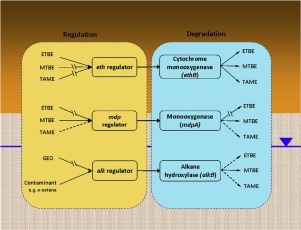Journal of Hazardous Materials ( IF 12.2 ) Pub Date : 2020-01-24 , DOI: 10.1016/j.jhazmat.2020.122046 S.F. Thornton , H.C.G. Nicholls , S.A. Rolfe , H.E.H. Mallinson , M.J. Spence

|
This review summarises the current state of knowledge on the biodegradation and fate of the gasoline ether oxygenate ethyl tert-butyl ether (ETBE) in soil and groundwater. Microorganisms have been identified in soil and groundwater with the ability to degrade ETBE aerobically as a carbon and energy source, or via cometabolism using alkanes as growth substrates. Aerobic biodegradation of ETBE initially occurs via hydroxylation of the ethoxy carbon and cleavage of the ether bond by a monooxygenase enzyme, with subsequent formation of intermediates which include acetaldehyde, tert-butyl acetate (TBAc), tert-butyl alcohol (TBA), 2-hydroxy-2-methyl-1-propanol (MHP) and 2-hydroxyisobutyric acid (2-HIBA). Slow cell growth and low biomass yields on ETBE are believed to result from the ether structure and slow degradation kinetics, with potential limitations on ETBE metabolism. Genes known to facilitate transformation of ETBE include ethB (within the ethRABCD cluster), encoding a cytochrome P450 monooxygenase, and alkB-encoding alkane hydroxylases. Other genes have been identified in microorganisms but their activity and specificity towards ETBE remains poorly characterised. Microorganisms and pathways supporting anaerobic biodegradation of ETBE have not been characterised, although this potential has been demonstrated in limited field and laboratory studies. The presence of co-contaminants (other ether oxygenates, hydrocarbons and organic compounds) in soil and groundwater may limit aerobic biodegradation of ETBE by preferential metabolism and consumption of available dissolved oxygen or enhance ETBE biodegradation through cometabolism. Both ETBE-degrading microorganisms and alkane-oxidising bacteria have been characterised, with potential for use in bioaugmentation and biostimulation of ETBE degradation in groundwater.
中文翻译:

乙基叔丁基醚(ETBE)在土壤和地下水中的生物降解和去向:综述
这篇综述总结了关于土壤和地下水中汽油醚含氧乙基叔丁基醚(ETBE)的生物降解和去向的最新知识。已在土壤和地下水中发现了微生物,该微生物能够以碳和能源的方式,有氧降解ETBE,或者通过使用烷烃作为生长底物的新陈代谢来降解。ETBE的好氧生物降解最初经由乙氧基碳和通过单加氧酶的醚键的裂解的羟基化发生时,与随后形成的中间体,包括乙醛,叔丁基乙酸酯(TBAC),叔丁醇(TBA),2-羟基-2-甲基-1-丙醇(MHP)和2-羟基异丁酸(2-HIBA)。据信,ETBE上的细胞生长缓慢和生物量低产是由于醚的结构和缓慢的降解动力学造成的,对ETBE代谢可能具有限制。已知可促进ETBE转化的基因包括eth B(在ethRABCD簇内),编码细胞色素P450单加氧酶和alkB编码烷烃羟化酶。在微生物中已经鉴定出其他基因,但是它们对ETBE的活性和特异性仍然很难鉴定。尽管在有限的领域和实验室研究中已经证明了这种潜力,但尚未证明支持ETBE厌氧生物降解的微生物和途径。土壤和地下水中共污染物(其他醚含氧化合物,碳氢化合物和有机化合物)的存在可能会通过优先代谢和利用可用的溶解氧来限制ETBE的需氧生物降解,或通过新陈代谢促进ETBE的生物降解。降解ETBE的微生物和烷烃氧化细菌均已被表征,具有潜在的生物增强作用和对地下水中ETBE降解的生物刺激作用。











































 京公网安备 11010802027423号
京公网安备 11010802027423号